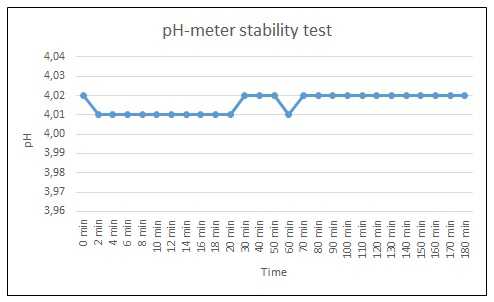Anybody know what the storage solution in the MW102 is? I'm surely gonna spill it some day and would like some handy.
What's the deal with storage solution btw?

Anybody know what the storage solution in the MW102 is? I'm surely gonna spill it some day and would like some handy.

No problem with doing things this way except...Am I being an idiot by keeping the MW102 probe in storage solution in a beaker, covered over with plastic film to slow evaporation (not very well - crystallization is crazy)?
Storage solutions are almost always saturated solutions of KCl. Thus water evaporation is not a problem from the POV of the strength of the solution. It stays saturated. Deposition of KCl crystals on the electrode is not a problem either. Just rinse them off with a stream of DI water from a lab squirt bottle.Seems like I'm burning a lot of storage solution and concerned about the amount of crystallization that gathers on the probe, beaker, everything.
Yes. That is how the manufacturer intends it to be stored. The sponge is there to retain some liquid it being important to keep the bulb moist rather than wet. The only problem with the storage cap approach is that KCl creep will eventually remove the liquid even if the electrode with cap is stored vertically so be sure to check it and top it off from time to time if you are using it infrequently.Can I safely saturate the - don't know what it's called, some sort of cap with a sponge at the bottom, a tube that slips over the electrode - can I saturate this, slip the probe in this, for storage?
You shouldn't be seeing this in the Hach because you shouldn't be filling the cap with storage solution. A few drops of DI water in the bottom of the cap with the meter stored vertically keep the humidity inside the cap high enough to keep bulb and junction hydrated."KCL creep happens", I get that on my Hanna big time, much less so on the Hach because it has an O-ringed cap unlike the Hanna.
It does.I'm surprised the MW102 doesn't have a probe cap
Can I safely saturate the - don't know what it's called, some sort of cap with a sponge at the bottom, a tube that slips over the electrode

No problem with doing things this way except... Storage solutions are almost always saturated solutions of KCl. Thus water evaporation is not a problem from the POV of the strength of the solution. It stays saturated. Deposition of KCl crystals on the electrode is not a problem either. Just rinse them of with a stream of DI water from a lab squirt bottle.
Yes. That is how the manufacturer intends it to be stored. The sponge is there to retain some liquid it being important to keep the bulb moist rather than wet. The only problem with the storage cap approach is that KCl creep will eventually remove the liquid even if the electrode with cap is stored vertically so be sure to check it and top it off from time to time if you are using it infrequently.
You shouldn't be seeing this in the Hach because you shouldn't be filling the cap with storage solution. A few drops of DI water in the bottom of the cap with the meter stored vertically keep the humidity inside the cap high enough to keep bulb and junction hydrated.
It does.
The MW 102 probe cap:
View attachment 574827
Anyone have feedback on meters since the last posting in 2016?
I have been reading over multiple threads however some of the information seems above my knowledge. I just want to make sure my mash water is in good range for efficiency.
Amazon is flooded with 14-16 dollar meters that seem like they fit the bill, but these can't possibly be worth dealing with are they?
Amazon is flooded with 14-16 dollar meters that seem like they fit the bill, but these can't possibly be worth dealing with are they?
Enter your email address to join: